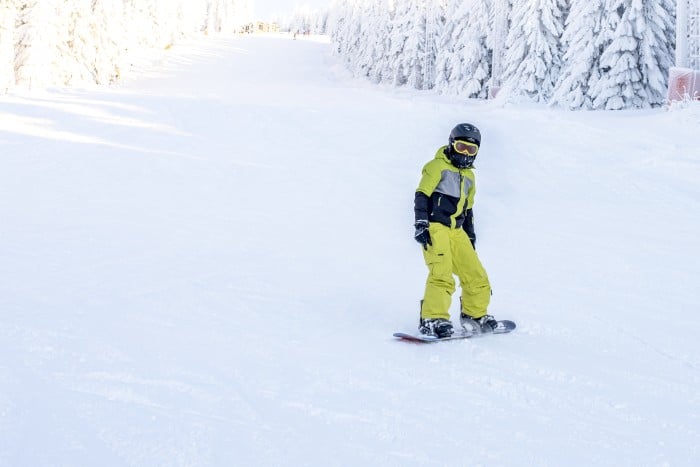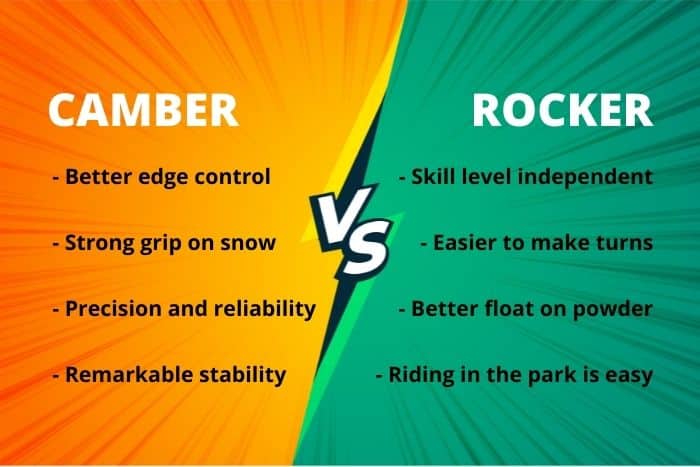What are the advantages that rocker snowboards have over other types of snowboards? If you are stuck in the middle and can’t make up your mind on a purchase, perhaps the pros and cons discussed here can help you with your decision. Here are the snippets:
The pros of rocker snowboards are: better floating on snow, easier to initiate turns, fun riding experience for beginners, less physically demanding, and are fun to ride in the park. The cons are: difficult to control at higher speeds, lack of precision, and unresponsive on icy terrain.
When considering what type of rocker to have on your new board, it’s also important to consider what kind of terrain you’ll be riding. This plays an important role in assessing the benefits and drawbacks of a snowboard’s shape.
Pros of a Rocker Snowboard
Rocker snowboards have some distinct advantages that set them apart from other snowboards. These are:
1. Better Float on Powder
The tip and the tail of a rocker board float on the snow, making the riding experience smooth and buttery, similar to surfing.
The rocker’s design ensures that you will always slide on top of the snow, saving you from the trouble of riding on your back foot or jumping to prevent being stuck in pow.
This ensures that you can maintain a balanced riding position and won’t tire as quickly.

2. Easier to Make Turns
The reverse arch design of the rocker snowboard reduces the contact length of the edges with the snow, making it easier to initiate turns and carves and reducing the chance of catching an edge.
This makes it the perfect board for tree runs, as you are able to turn quickly throughout the trees.
3. Awesome for Beginners
When a snowboard’s edge gets caught in the snow unexpectedly, known as catching an edge, the rider is likely to fall flat on the snow and injure themselves.
Catching an edge is a common incident among beginners of the sport.
Fortunately, rocker boards are forgiving in nature, so it is difficult to catch an edge as they are raised away from the snow.
This makes it an easier board for beginners of the sport. However, beginners may have a little trouble with controlling a rocker initially.
4. Makes Riding in the Park Easier
Rocker boards are designed for simpler and easier riding, as the board has less edge contact with the ground.
This makes it easy to butter and not fall when hitting boxes, rails, or anything else you come across in the park.
A rocker board allows you to start your spins faster and recover quickly from under-spun or off-axis landings.
Cons of Rocker Snowboard
Rocker snowboards are awesome, yes. But here are things to keep in mind before you make your purchase. Rockers are:
1. Unstable at Higher Speeds
The very nature of what makes a rocker snowboard fun, its upturned tip and tail, is also one of the main drawbacks as they become unstable at higher speeds causing you to slide out.
A rocker snowboard lacks the edge control offered by traditional camber boards that allow you to shift your weight to adjust the amount of edge in contact with the snow.
So if you’re into racing down the mountain, you may want to stick with a traditional camber board.
2. Lacks Responsiveness
Another drawback of rocker snowboards is their lack of responsiveness.
Similar to its lack of stability at high speeds, the reverse arc of the rocker snowboard creates less edge control against the snow, making the board unresponsive on hard-packed and uneven runs.
Many riders complain that more effort is needed to control the board, particularly on icy terrain, and tricks like ollies require extra effort on rockers compared to cambers.
Camber vs Rocker
Camber snowboards have some distinct advantages over rocker snowboards. For example, their flexible midsection gives them good edge control during turns.
Due to this, traditional camber has been stable in the snowboarding scene for decades.
Another cool feature with cambers is that you can apply your body weight to flatten the camber, resulting in continuous edge control and a strong grip on icy snow.
This gives stability to your snowboard during difficult turns. Many people love camber for its precision and reliability at faster speeds where the rocker just doesn’t cut it.
When the rocker first hit the market, new designs combining the camber and the rocker models started popping out to address the special needs of the terrain and trails.
Today, most snowboards are a combination of the traditional camber and rocker models geared towards your needs. Here is an overview of what’s best in which terrain.
Terrain Types and the Best Snowboards
1. All-mountain
All mountain rocker snowboards are the preferred choice because of their ability to initiate easier turns, and their excellent float from lifted tails and tips is a massive advantage.
Another popular choice is the combination of rockered tip and cambered midsection snowboards, which offer great versatility.
2. Groomed trails
Camber snowboards rule this terrain due to superior edge control and stability at higher speeds.
Rocker boards can still perform in resort runs but are less reliable on hard-packed snow, as edge control is crucial under this condition.
A combination of rocker and camber snowboard is a good alternative as well.
3. Pow
Rocker boards are the go-to choice on powder, and their design smoothly compliments them as they dominate this terrain.
The lifted tips and tails float effortlessly on soft powder, giving you a surf-like feeling.
As the tip and tail of the board are raised higher than a camber snowboard, the amount of pressure you need to put on your back leg when riding powder is reduced, making it less tiring.
4. Park and pipe
Many snowboarders love camber boards in park and pipe because of the stability they provide when doing jumps and tricks.
The springiness of the camber gives you excellent edge control when doing jumps.
Yet, rocker boards are much better for dodging hang-ups on rails and are generally better for presses.

Your Ideal Snowboard
Now that we have discussed the ideal terrain conditions for the rocker and camber snowboards, you should also consider your skill level when purchasing.
Here is what we would advise:
Rocker Boards Are Superb Regardless of Your Skill Level
Players of all skill levels can benefit from the rocker snowboard.
Beginners benefit from their floating, buoyant, and forgiving nature, while pros and intermediate riders love their easy-to-ride, fun feels on mountains at lower speeds.
Rocker-Camber Combinations Are the Best All-Rounders
The versatility offered by combining the designs of rocker and camber boards is sought after by many expert-level riders.
To satisfy their needs, manufacturers combine rocker designs with camber and create snowboards that address specific terrain needs.
If you are confident in your skills and terrain needs, these boards should be your go-to choice when making the purchase.
Conclusion
The advantages of rocker snowboards are that they are fun to ride, easy to turn, physically less demanding, and have a surf-like feeling when riding powder.
The drawbacks are they are unreliable and difficult to control at higher speeds, lack precision, and can be unresponsive on hard-packed snow due to their design.
When making a decision for purchase, keep in mind the type of terrain you will be riding on and your skill level. All the best!
